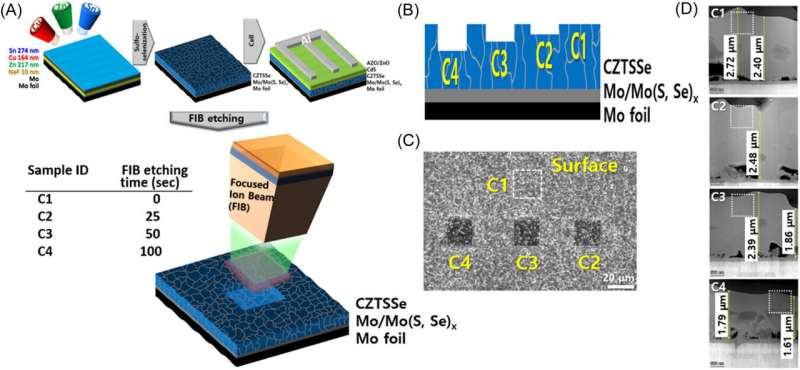This article has been reviewed according to Science X's editorial process and policies. Editors have highlighted the following attributes while ensuring the content's credibility:
fact-checked
proofread
Researchers identify cause of electron-hole separation in thin-film solar cells to increase solar cell efficiency

A team of researchers have collaborated to characterize electron-hole separation in the light-absorbing layer of kesterite thin-film solar cells. This study is expected to improve the efficiency of solar cells and promote the use of green energy. The research is published in the journal Carbon Energy.
As a device that generates electricity by converting light energy from the sun into electrical energy, solar cells are garnering attention as the next source of energy as they are eco-friendly and can utilize unlimited solar resources. In particular, kesterite thin-film solar cells made of materials, such as copper, zinc, and tin, have the advantages of being balanced with resources and being cost-effective. Despite the research conducted so far, the efficiency of kesterite thin-film solar cells remains relatively low.
Kesterite thin-film solar cells absorb light from the sun to create electrons and holes, which combine again with each other to generate electricity. However, during the process, losses occur. To tackle this problem, identifying the nature of the electron-hole separation that causes the electrons and holes to rapidly separate is important.
Against this backdrop, this study used scanning probe microscopy to characterize electron-hole separation within and at the interface between crystals in the light-absorbing layer. The research team investigated the structural characteristics of the light-absorbing layer and the efficiency of electron-hole separation. Most importantly, they analyzed in detail how different energy levels within and at the interface of crystals affect electron-hole separation.
The research team, including Kee-jeong Yang, Dae-hwan Kim, and Jin-gyu Kang at the Division of Energy & Environmental Technology, DGIST, and others, said that the energy level is higher at the crystal interface at the surface and near-surface area of the light-absorbing layer of thin-film solar cells, and electrons move inside crystals, allowing a flow in crystals to be dominant in the current. However, opposite behaviors emerge inside the light-absorbing layer. In this case, defects at the crystal interface may cause electron-hole recombination losses.
The research team suggested the importance of uniformly creating the light-absorbing layer with a higher energy level at the interface between crystals than within crystals to improve the efficiency of kesterite thin-film solar cells; appropriate elemental doping can be utilized to do so.
Senior Researcher Kee-jeong Yang at the Division of Energy & Environmental Technology said, "While atomic force microscopy has so far been limited to the surface of the light-absorbing layer in the field of solar cell research, this study holds significance as it suggests the method that can be used to analyze the entire light-absorbing layer and its results.
"The methodology of atomic force microscopy used in this study is expected to provide directions to understand the nature of carrier behaviors not just in thin-film solar cells but also across many other applications."
More information: Dae‐Ho Son et al, Vertical plane depth‐resolved surface potential and carrier separation characteristics in flexible CZTSSe solar cells with over 12% efficiency, Carbon Energy (2024). DOI: 10.1002/cey2.434



















